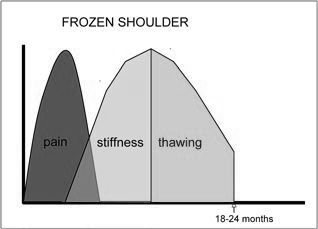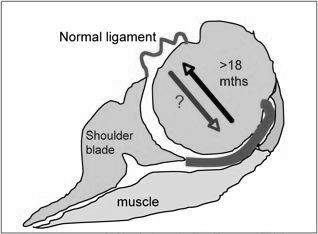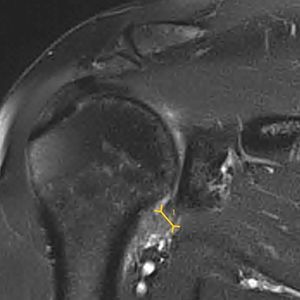Frozen Shoulder
What is a Frozen Shoulder?
Frozen shoulder, also known as adhesive capsulitis, is a condition characterised by pain, stiffness, and a limited range of motion in the shoulder joint.
It occurs when the capsule surrounding the shoulder joint thickens and tightens, restricting movement. Frozen shoulder typically develops gradually and can take months or even years to resolve fully.
How Does Frozen Shoulder Impact Your Anatomy and Health?
A frozen shoulder impacts your anatomy by causing the shoulder joint capsule to become inflamed, thickened, and tight. This reduces the synovial fluid, which normally lubricates the joint and allows for smooth, pain-free movement. Consequently, the shoulder joint becomes stiff and painful, significantly limiting your range of motion and affecting your ability to perform daily activities such as dressing, reaching overhead, or even sleeping comfortably.
Moreover, a frozen shoulder can substantially impact your overall health and well-being. Persistent pain and limited mobility may lead to a decline in physical activity, contributing to weight gain, muscle atrophy, and reduced quality of life. Furthermore, the ongoing discomfort can result in emotional distress, including feelings of frustration, anxiety, and depression.
Who is at Risk of Frozen Shoulders?
Although anyone can develop a frozen shoulder, certain factors increase your risk, including:
- Age: Frozen shoulder is more common in individuals between 40 and 60 years old.
- Gender: Women are more likely to experience frozen shoulders than men.
- Medical conditions: Those with chronic health issues such as diabetes, thyroid disorders, or cardiovascular disease are more likely to develop the condition.
- Immobility: Prolonged periods of shoulder immobility, such as after surgery or an injury, can contribute to the development of a frozen shoulder.
Causes of Frozen Shoulder
Frozen shoulder is caused by inflammation of the ligaments holding the shoulder bones to each other. The shoulder capsule becomes thick and tight, and stiff bands of tissue called adhesions may develop.
Symptoms of Frozen Shoulder
The symptoms of a frozen shoulder typically develop slowly and worsen over time. They can include:
- Pain in the shoulder joint that is often worse at night.
- Stiffness and limited range of motion in the shoulder.
- Difficulty lifting the arm above the head.
- Limited mobility in the shoulder joint.

Stages of Frozen Shoulder
Frozen shoulder symptoms typically develop gradually and worsen over time. They can be divided into three stages:
- Freezing stage: During this stage, the pain gradually increases, and shoulder mobility decreases. The pain might be worse at night and disrupt sleep. This stage can last anywhere from six weeks to nine months.
- Frozen stage: In the frozen stage, pain may diminish, but the stiffness remains, and the range of motion becomes severely limited. Daily activities that require reaching or lifting may become challenging. This stage can last four to six months.
- Thawing stage: The final stage, known as the thawing stage, is characterised by gradually improving the shoulder's range of motion and decreased pain. Full or near-full recovery may take anywhere from six months to two years.
It is essential to consult with an orthopaedic surgeon if you suspect you have a frozen shoulder or experience ongoing shoulder pain and stiffness. Early diagnosis and intervention can help manage the symptoms and prevent further complications.


Diagnosis of Frozen Shoulder
Diagnosing a frozen shoulder can be challenging, as the symptoms can mimic other shoulder conditions. Often, an orthopaedic surgeon can identify a frozen shoulder with a history and a physical exam. Diagnostic methods include
Consultation
During the consultation, the surgeon will
- Take a medical history: concentrating on pain, disability, treatments and associated medical conditions.
- Perform a physical examination: documenting shoulder range of motion and strength.
Imaging Tests
The nature of any loss of the joint space or bone spur formation imaging scans are required:
- X-rays – Dense structures, such as bone, show up clearly on x-rays. The X-rays in the non-traumatic frozen shoulders are usually normal. X-rays help exclude arthritis or other rare causes of shoulder pain and stiffness
- Ultrasound – Can show the state of the rotator cuff tendons. Intact tendons in the setting of severe restriction in movement suggest a frozen shoulder.
- MRI scans – are generally not required and are reserved only for unusual cases.

Treatment for Frozen Shoulder
Treatment for frozen shoulder aims to alleviate pain, reduce inflammation, and restore the shoulder's range of motion. The treatment approach usually involves a combination of conservative (non-surgical) methods, with surgery reserved for severe cases or when conservative treatments fail to provide relief. Here are the most common treatment options:
- Pain management: Over-the-counter pain relievers, such as nonsteroidal anti-inflammatory drugs (NSAIDs) like ibuprofen, can help manage pain and reduce inflammation.
- Physical therapy: A qualified physiotherapist can guide you through targeted exercises and stretches designed to improve your shoulder's range of motion, flexibility, and strength. Following the physiotherapist's recommendations and performing the exercises regularly is crucial.
- Heat and cold therapy: Applying heat to the affected shoulder can help relax the muscles and reduce pain, while cold therapy may help alleviate inflammation and swelling. Alternating between the two can be beneficial during the treatment process.
- Corticosteroid injections: In cases where pain and inflammation are severe, your healthcare professional may recommend corticosteroid injections. These injections can provide temporary relief but should be used cautiously as they may have side effects, especially with repeated use.
- Hydrodilatation: This procedure involves injecting sterile fluid into the shoulder joint to stretch the joint capsule and improve mobility. It is typically performed under imaging guidance, such as ultrasound, and may provide relief for some patients.
- Surgery: In severe cases, surgery may be necessary to release the capsule surrounding the shoulder joint.
Frozen Shoulder Surgery
- Manipulation under anaesthesia (MUA): The patient is put under general anaesthesia during this procedure. The surgeon manipulates the shoulder joint to break up scar tissue and adhesions. This allows the joint to move more freely and reduces pain and stiffness.
- Arthroscopic release: In this procedure, the surgeon makes small incisions in the shoulder and inserts a tiny camera and surgical instruments to cut through the tight capsule surrounding the shoulder joint. This allows the joint to move more freely and reduces pain and stiffness.
What if Frozen Shoulder is Untreated?
If left untreated, a frozen shoulder can lead to long-term stiffness and limited mobility in the shoulder joint. This can impact daily activities, making it difficult to perform routine tasks such as getting dressed or reaching for items on high shelves.
An untreated frozen shoulder can also lead to the development of other shoulder conditions, such as rotator cuff tears or impingement syndrome.



